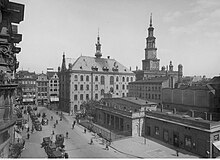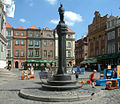Old Market (Poznan)

Old Market ( Polish: Stary Rynek ) is the name of the square in Poznan , which was created as a marketplace for the buying and selling of goods when the city was founded in 1253 . With an area of around two hectares, the Old Market is the third largest market square in Poland (after the Kraków and Wrocław market places ) and one of the largest in Europe. Until the Second World War , it was the center of the city's economic and political life. As a result of the war, it was almost completely destroyed. After the reconstruction, thanks to the successful restoration, it is now one of the most visited tourist attractions in the city.
It has a square floor plan with a side length of about 141 m and, typical of the Polish Rynek , surrounds a group of public buildings and shops.
About history
When the city was founded in 1253, the locator Posens, Thomas from Guben , made a tenth of the 20 hectares available for the city available for the city's market square. On each side (about 140 m in length) 16 pieces of land were identified, which the locator and the first members of the patriciate had available when the city was founded. The first houses in the city were built on top of this using a closed construction method . A total of twelve streets lead to the square.
Buildings on the Old Market
At the end of the Second World War, the old town of Poznan was badly damaged. The patrician houses around the square, mostly from the Baroque era, were also destroyed and were rebuilt in their historical form after 1945, or at least their facades.
The building group in the middle of the square includes:
- Old Town Hall - built in the 1550s, the most important architectural monument in the city and one of the most important Renaissance town halls in Europe. Today the Museum of the City of Poznan.
- Row of buildings of the three-storey shopkeepers built from 1535 with their characteristic arcade , originally shops and apartments of small traders.
- behind it two elongated, modern functional buildings for the military museum and the city gallery "Arsenal" for modern art
- behind the town hall the city scales , a reconstruction based on the state of the 16th century
- on the west side the classicist Hauptwache - a facility rebuilt in 1787 by Johann Christian Kamsetzer , in it today the Museum of the Poznan Uprising of 1918/19
East Side:
- Stary Rynek 42–45: The three town houses from the 16th to 19th centuries house the musical instrument museum
- No. 50, 51: The only two houses from the late Middle Ages
- Wodna No. 27: The Renaissance palace of the Górka family from 1549 forms the south-east corner of the square. Today it houses the Archaeological Museum, which focuses on the archeology of Poland from the Stone Age to the Middle Ages and excavations in Athribis, Lower Egypt .
West side:
- No. 75: The Golden Lion Pharmacy from the early 19th century was only slightly damaged in World War II
- No. 78: Dzialynski Palace (Pał ac Działyńskich) - early classical building from the 18th century
- No. 84: House of the town hall builder Giovanni Battista di Quadro , today a literary museum dedicated to Henryk Sienkiewicz , author of the famous historical novel Quo Vadis
North side:
- the neoclassical Mielzynski Palace (Pałac Mielżyńskich) - (1795–1798)
- The Hotel Rzymski is not far from the Old Market .
Sculptures in the old market
Sculptures from different centuries exist on the old market. There are also four fountains: the one for Proserpina from 1766, that for Bamberka from 1915, and the Apollon , Neptune and Mars from 2002 to 2005 .
The pillory (16th century)
Nepomuk statue (1724)
Bamberka fountain (20th century) on the west side of the town hall
See also
Individual evidence
Web links
Coordinates: 52 ° 24 ′ 30 ″ N , 16 ° 56 ′ 4 ″ E













